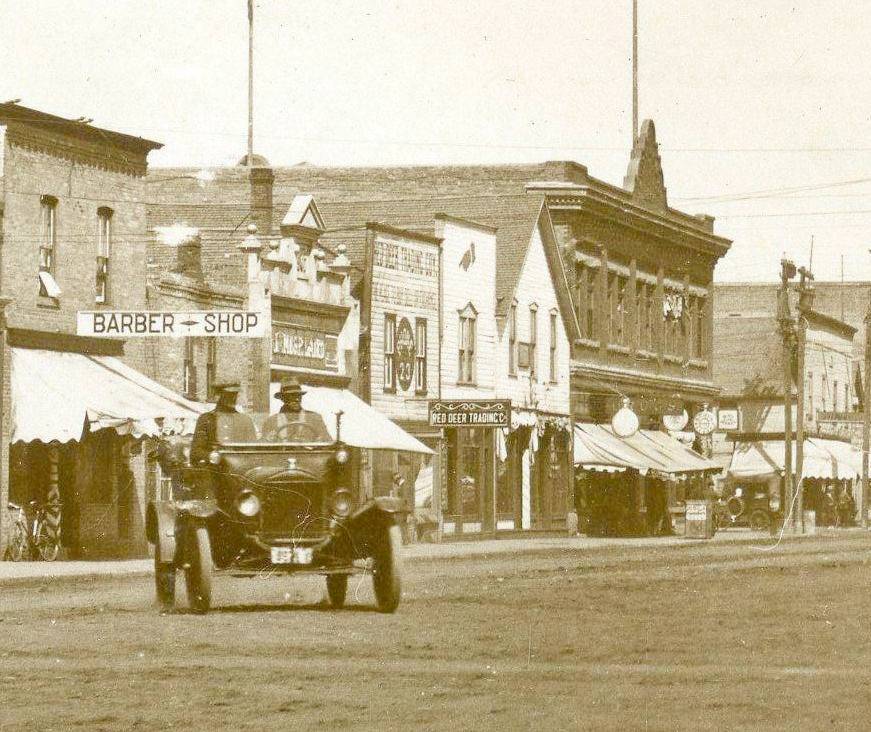Red Deer 100 years ago was a grim place. The First World War had been raging since the summer of 1914. The loss of life amongst the local young men fighting overseas was horrific.
Many of those who came home returned with severe injuries to their minds, as well as their bodies. Consequently, a special soldiers’ hospital was opened on the East Hill in the old Alberta Ladies College.
Surprisingly, there was one bright spot during those hard times.
That was the enormous growth in the popularity of automobiles in the community and the establishment of Red Deer’s first car dealerships.
There were a number of reasons why automobile ownership flourished during the War years. First, just as there were astonishing losses of human life overseas, the losses of horses, the main means of transportation, were also truly horrendous. If soldiers seemed to be treated as little more than ‘cannon fodder’ in the battlefields, that was even truer when it came to horses.
The military increasingly scrambled to secure replacements, dubbed ‘remounts’.
Supply could not keep up with demand, even in agricultural heartlands such as Central Alberta. Prices consequently soared. As the price of horses jumped, the cost of purchasing an automobile seemed less daunting.
Many other supplies and equipment fell into short supply as they were diverted to the War effort.
Rationing became common. However, the centre of the developing automobile industry was in the northern United States. Hence, the supply of cars for the domestic market remained strong, at least until the latter part of 1917 when the U.S. finally entered the War.
Moreover, the Red Deer and Central Alberta economy was agriculture-based.
The demands of the War drove up the prices of virtually all food stuffs and livestock, not just horses. Also, 1915 brought one of the biggest harvests in history and the succeeding years were pretty good as well.
Consequently, farmers had lots to sell at ever increasing prices. Their incomes took a big jump. Automobiles became increasingly affordable.
Cars had been around for a few years before the start of the War. The very first local car was a Cadillac M, purchased by A.E. Short of Pine Lake. The first car in Red Deer was a McLaughlin Buick, purchased by Dr. Richard Parsons in May 1909.
By the spring of 1912, there were 55 cars in Red Deer.
The Red Deer Automobile Club was formed in April. Meanwhile, Ivan Greene opened the first garage in Red Deer in 1910 in the old Methodist Church on Blowers (51) St.
Harvey Bawtintheimer started the Alberta Garage on Alexander (48) St. in 1911. A major part of his business was providing winter storage of cars as the early automobiles were rarely the equal to the challenges of an Albertan winter.
In 1916, Edward Michener, in partnership with his brother Norman, decided to start Red Deer’s first full automobile dealership, selling Chevrolet cars. The new firm, Michener Brothers, initially operated out of the old Hepworth-Trimble flour and feed mill on Mann (49) St.
While Bawtinheimer had acted as a dealer for the sale of Ford cars, it was Fred Lund who started the first full Ford dealership, opening for business in 1917.
Fords had become the most popular car across North America as they were relatively easy to buy, simple to drive, and cheap and easy to repair. Hence, Lund’s business boomed.
By 1918, Michener Brothers were doing so well that they built a large brick garage on the southeast corner of Gaetz Avenue and what is now 48 St. This building is still standing (Copies Now business print centre).
With the automobile trade doing so well, others jumped into the business.
Often they had been farm implement dealers. There were soon quite an array of cars available – Overlands (Russells), McLaughlin-Buicks and Dodges, in addition to the Fords and Chevrolets.
A very deep economic depression followed the end of the War in November 1918. The local automobile sector suffered as well. However, by the mid-1920s, the economy recovered and a new ‘golden age’ for automobiles commenced.



